A fluorescent three-sensor array for heavy metals in environmental water sources†
Abstract
Toxic heavy metal detection in water sources is crucial due to the detrimental social and environmental threats these metals pose. Traditional methods of metal detection in water rely on expensive and sophisticated technologies, limiting their availability for on-site detection. Here, we report a six-member fluorescent sensor array for 100% successful classification of 9 metal ions in water. The array consists of the commercially available fluorescent dye, Calcein Blue, and 5 analogues that were all synthesised in three steps or less. To further increase simplicity, we report the reduction of the number of sensing elements from 6 to 3 using multivariate statistics to arrive at an array still capable of 100% correct classification. The utility of the three-member fluorescent sensing array was confirmed in environmental pond water samples. The array's flexibility was also demonstrated through its successful classification of micromolar concentrations of Pb2+ for quantitative analysis of heavy metals in water samples.



 Please wait while we load your content...
Please wait while we load your content...